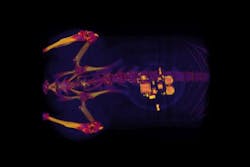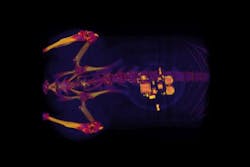Implantable device uses light from LEDs to treat severe bladder issues
For the last 30 years or so, many with severe bladder issues have been treated with stimulators that send an electric current to the nerve that controls the bladder. Such implants improve incontinence and overactive bladder, but they also can disrupt normal nerve signaling to other organs. Recognizing this, a team of researchers from the Washington University School of Medicine in St. Louis (St. Louis, MO), the University of Illinois at Urbana-Champaign (Champaign, IL), and the Feinberg School of Medicine at Northwestern University (Chicago, IL) has developed an implantable device with tiny light-emitting diodes (LEDs) that has potential to help people with bladder problems bypass the need for medication or electronic stimulators.
The researchers created a soft, implantable device that can detect overactivity in the bladder and then use light from biointegrated LEDs to reduce the urge to urinate. The device works in laboratory rats and one day may help people who suffer incontinence or frequently feel the need to urinate.
During a minor surgical procedure, the researchers implant a soft, stretchy belt-like device around the bladder. As the bladder fills and empties, the belt expands and contracts. The researchers also inject proteins called opsins into the animals' bladders. The opsins are carried by a virus that binds to nerve cells in the bladder, making those cells sensitive to light signals. This allows the researchers to use optogenetics—the use of light to control cell behavior in living tissue—to activate those cells.
Using Bluetooth communication to signal an external handheld device, the scientists can read information in real time and, using a simple algorithm, detect when the bladder is full, when the animal has emptied its bladder, and when bladder emptying is occurring too frequently.
This CT scan of a rat shows a small device implanted around the bladder; the device uses light signals from tiny LEDs to activate nerve cells in the bladder and control problems such as incontinence and overactive bladder. (Image credit: Gereau Lab)
"When the bladder is emptying too often, the external device sends a signal that activates micro-LEDs on the bladder band device, and the lights then shine on sensory neurons in the bladder. This reduces the activity of the sensory neurons and restores normal bladder function," explains Robert W. Gereau IV, Ph.D., the Dr. Seymour and Rose T. Brown Professor of Anesthesiology at Washington University School of Medicine, and one of the study’s senior investigators.
The researchers believe a similar strategy could work in people. Devices for people likely would be larger than the ones used in rats, and could be implanted without surgery, using catheters to place them through the urethra into the bladder.
"This example brings together the key elements of an autonomous, implantable system that can operate in synchrony with the body to improve health: a precision biophysical sensor of organ activity; a noninvasive means to modulate that activity; a soft, battery-free module for wireless communication and control; and data analytics algorithms for closed-loop operation," says John A. Rogers, Ph.D., the study’s other senior investigator and a professor of materials science and engineering at Northwestern University.
Gereau and Rogers expect to test similar devices in larger animals. The researchers also believe the strategy could be used in other parts of the body—treating chronic pain, for example, or using light to stimulate cells in the pancreas to secrete insulin. One hurdle, however, involves the viruses used to get light-sensitive proteins to bind to cells in organs.
"We don’t yet know whether we can achieve stable expression of the opsins using the viral approach and, more importantly, whether this will be safe over the long term," Gereau says. "That issue needs to be tested in preclinical models and early clinical trials to make sure the strategy is completely safe."
Full details of the work appear in the journal Nature.

